
Working Through COVID-19
Return to Work Survey
As provinces move to ease restrictions, Canadian organizations must consider a return of their employees to physical workplaces. With COVID-19 still active, what will this shift look like, and how prepared are employers for the risks? How will this impact working arrangements in the long term?
The Conference Board of Canada asked organizations across the country how they’re planning to bring employees back to physical workplaces, and what measures they are putting in place.
Here’s what we found.
Note: Survey responses were collected on Monday, May 11, 2020. These findings are part of a Conference Board series on work and pay during the COVID-19 pandemic. Stay tuned for updates as this situation evolves.
Few organizations fully prepared to reopen workplaces
Q: When governments lift restrictions related to your location(s) and/or industry, how prepared is your organization to reopen workplaces?
(n = 279; percentage of organizations)
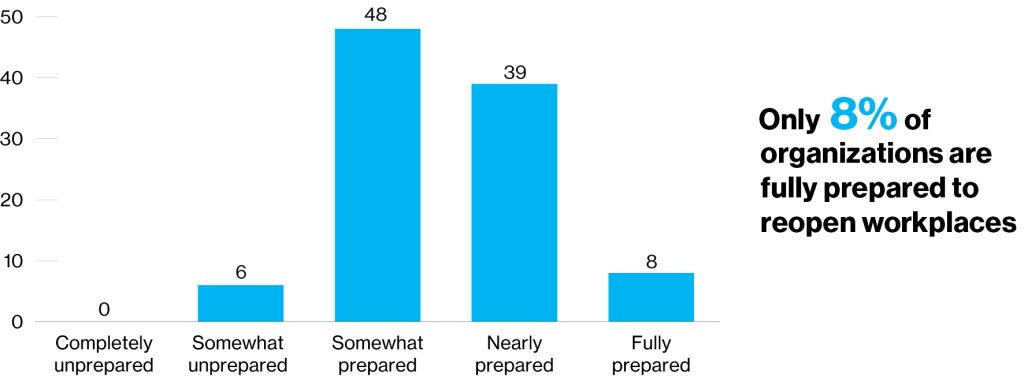
Note: Total does not add to 100 due to rounding.
Source: The Conference Board of Canada.

Throughout the pandemic, many employees have been working remotely. With easing restrictions, employers must consider whether they will be calling these employees back to the workplace.
Despite only a small portion of employers currently fully prepared to reopen, 40 per cent will require employees currently working remotely to return to the workplace in some capacity. This is most common in transportation and warehousing, where 58 per cent of employers have taken this approach.
Not surprisingly, approximately half of organizations in educational services, as well as in health care and social assistance, will be calling employees back to the workplace.
Public and private sector organizations are taking similar approaches, with roughly 40 per cent of organizations in both sectors bringing employees back to work in some capacity.
Organizations flexible on remote workers’ return
Q: As restrictions ease but the pandemic remains active, what is your organization’s approach to bringing employees currently working remotely back to the workplace?
(n = 286; percentage of organizations)
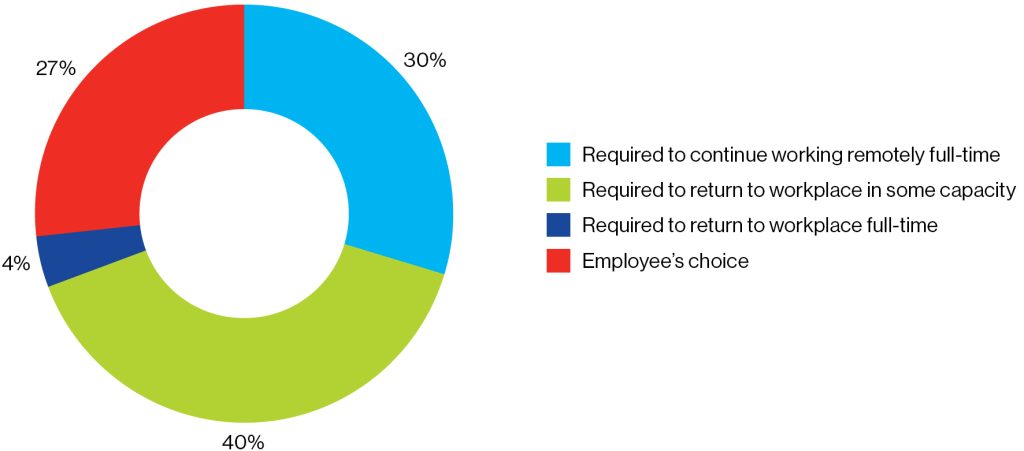
Note: Total does not add to 100 due to rounding.
Source: The Conference Board of Canada.

Some employees will be exempt from returning, even if they cannot perform their jobs remotely.
Most organizations will ask employees at high risk of severe illness from COVID-19 to remain home. Risk factors include a weakened immune system, age above 65, and underlying medical conditions such as heart disease, hypertension, and diabetes.
Only half of employers will allow employees not comfortable returning to the workplace to stay home.
At risk? Stay away
Q: Which of the following conditions would exempt employees from returning to the workplace?
(n = 272; percentage of organizations)

Note: Total does not add to 100 as more than one response could be selected.
Source: The Conference Board of Canada.
More than half of employers will be screening employees with a questionnaire upon arrival; 1 in 4 will also be temperature screening.
Plan for return
Phased approach is top choice for return to the workplace
Q: For employees who are coming back to the workplace, how are you managing their return?
(n = 288; percentage of organizations)
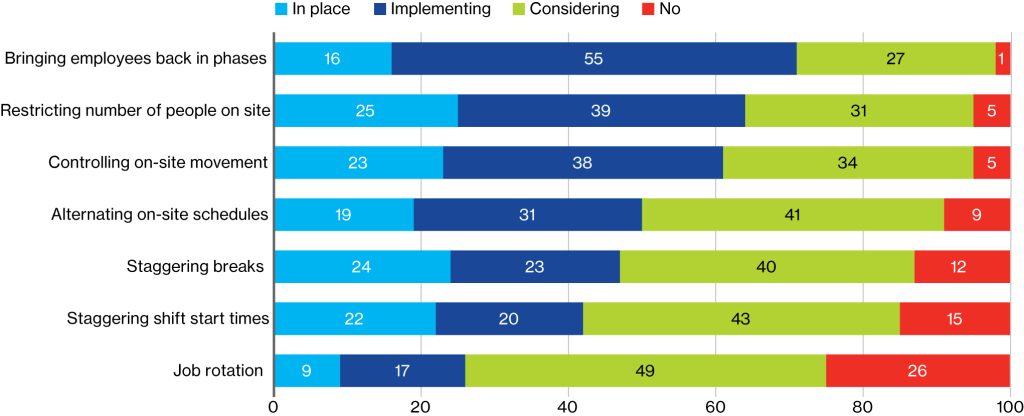
Note: Totals may not add to 100 due to rounding. Sample size indicates the number of organizations that gave a response for at least one of the above options.
Source: The Conference Board of Canada.
With restrictions lifting and workplaces starting to reopen, major concerns among employers include ensuring appropriate physical distancing and the potential for a site outbreak. Therefore, it is not surprising that the majority of organizations are bringing employees back in phases and restricting the number of people on site.
Once on site, employee safety will be a top priority.
Safety measures
A mix of safety measures in the works
Q: Is your organization implementing any of the following measures to ensure employees’ safety while at the workplace?
(n = 291; percentage of organizations)
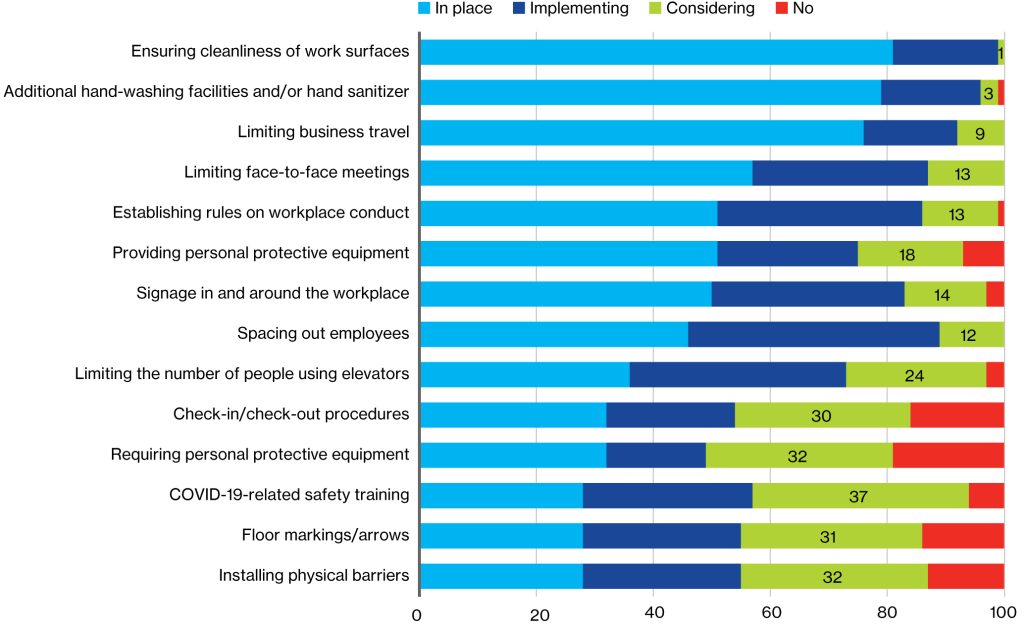
Note: Totals may not add to 100 due to rounding. Sample size indicates the number of organizations that gave a response for at least one of the above options.
Source: The Conference Board of Canada.

In the event of a site outbreak or a second wave of the pandemic, 28 per cent already have a plan in place for a workplace re-exit. A further 62 per cent are in the process of developing a plan.
For organizations with unionized employees, employers and unions must work together on approaches to bring employees back into the workplace. From the employers’ perspective, most organizations are indicating some degree of alignment with their union partners.
Employers signal alignment with unions on reopening plans
Q: If your organization has unionized employees, how aligned is your organization with the union(s) on the approach to the reopening of workplaces?
(n = 142; percentage of organizations)

Source: The Conference Board of Canada.

What does this mean for long-term work arrangements?
The degree to which employees will continue working remotely post-pandemic remains to be seen. We asked organizations about their approach to remote work pre- and post-pandemic. Many indicated a shift to remote work.
A shift in practice
Q: Which of the following best reflects your organization’s remote work approach pre- and post-pandemic?
(n = 288; percentage of organizations)
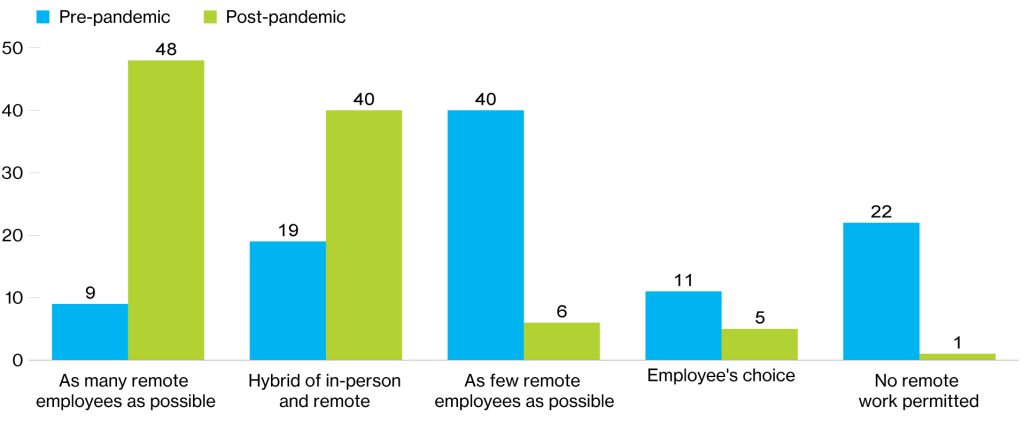
Note: Totals may not add to 100 due to rounding.
Source: The Conference Board of Canada.

